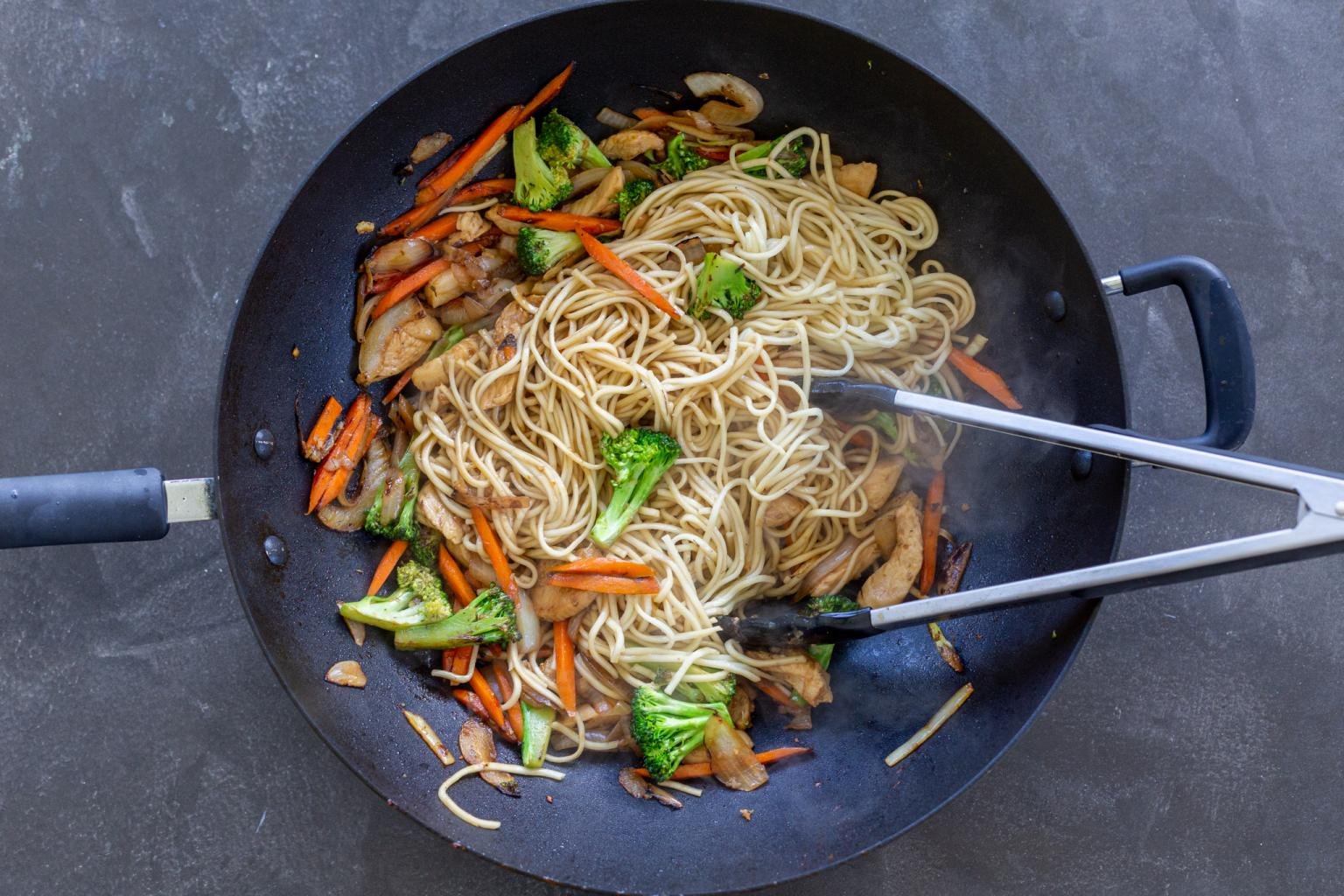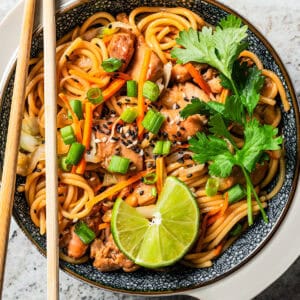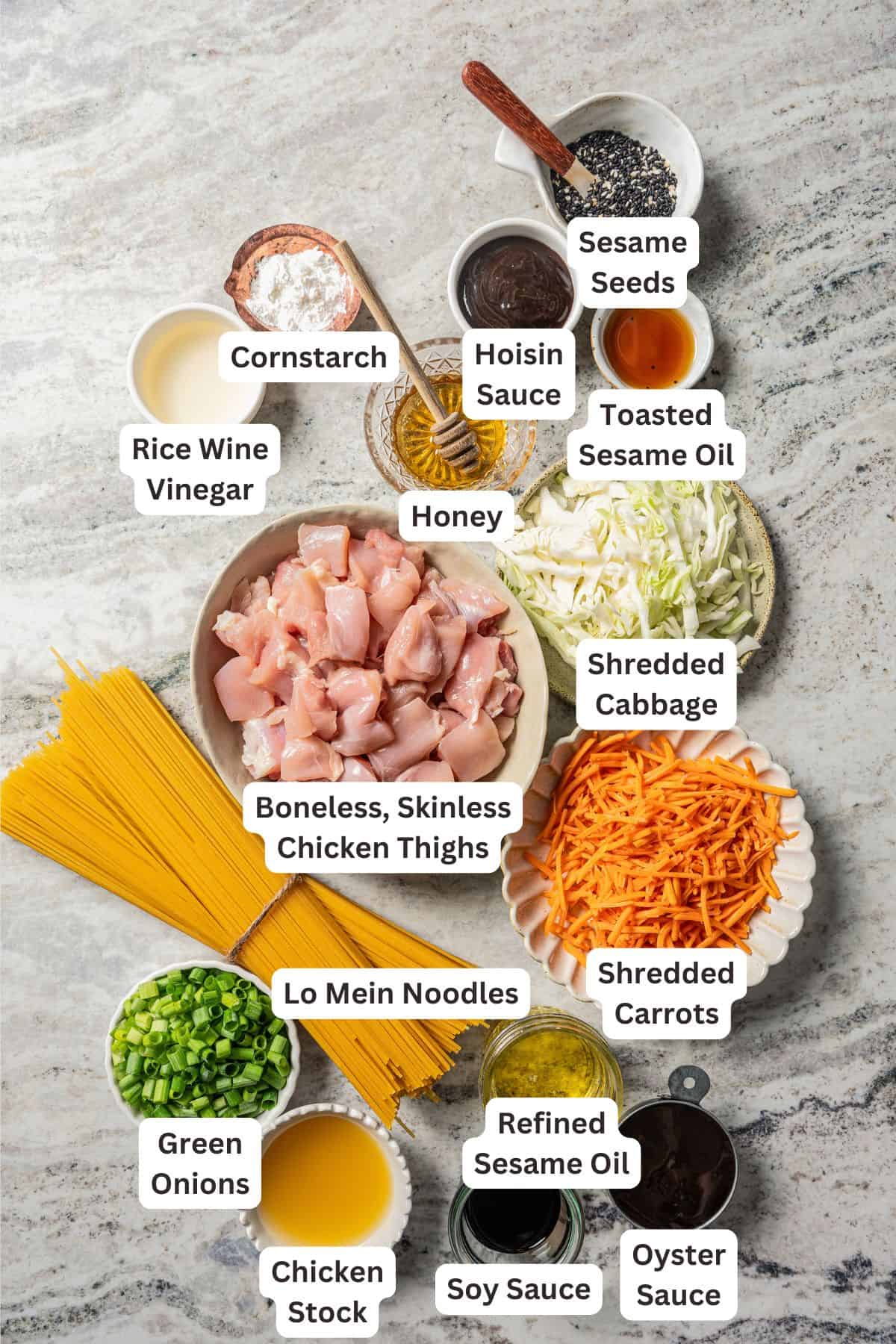Chicken lo mein, a staple of Chinese-American cuisine, is a delicious noodle dish that combines tender chicken, fresh vegetables, and a savory sauce. But what exactly goes into this beloved takeout favorite? In this comprehensive guide, we’ll break down the key components of chicken lo mein and explore some common variations.
The Noodles
The star of the show in any chicken lo mein is the noodles. Authentic lo mein uses fresh or dried egg noodles made from wheat flour and eggs. The noodles should have a bright yellow color from the eggs and a slightly chewy, al dente texture when cooked.
Popular options include
- Fresh lo mein noodles: Sold refrigerated or frozen in Chinese grocery stores. They come pre-cooked or uncooked.
- Dried lo mein noodles: Widely available in the Asian foods aisle. They need to be boiled before using.
Avoid using spaghetti or linguine, as their thinner shape and texture is quite different from traditional lo mein noodles.
The Chicken
Chicken provides the protein in this noodle dish. Boneless, skinless chicken thighs or breasts are most commonly used. The chicken is typically cut into small, bite-sized pieces then marinated before cooking to help it stay tender and juicy.
Popular marinades include:
- Soy sauce
- Rice wine or dry sherry
- Fresh ginger and garlic
- Sesame oil
- Cornstarch
The chicken is then stir-fried in a wok or skillet over high heat until lightly browned and cooked through.
The Vegetables
The vegetable component adds fresh flavors, colors, textures, and nutrients. While recipes can vary, some popular choices include:
- Cabbage: Provides crunch and subtle sweetness
- Carrots: For sweetness, color and firm bite
- Celery: Offers crispiness and light savory flavor
- Bell peppers: Contribute a subtle smoky taste
- Mushrooms: Shiitake or button mushrooms add an earthy, umami quality
- Scallions: Provide a bright, mild onion flavor
- Bean sprouts: Give a satisfying crunch
The vegetables are stir-fried just until tender-crisp before combining everything
The Sauce
The sauce brings all the components together, coating the noodles and vegetables in a rich, savory flavor. A typical lo mein sauce contains:
- Soy sauce: Salty, umami base
- Oyster sauce: Rich and savory flavor
- Toasted sesame oil: Nutty aroma and taste
- Rice wine: Enhances other flavors
- Sugar: Adds subtle sweetness
- Cornstarch: Thickens the sauce
- White pepper: Warming heat
- Ginger and garlic: Punch of aromatics
Getting the sauce right is key. The ideal lo mein sauce strikes a balance of salty, sweet, savory and spicy flavors. Feel free to tweak recipes to suit your tastes!
Common Additions and Variations
While the core ingredients stay relatively consistent chicken lo mein allows for plenty of customization. Some popular variations include
- Spicy lo mein: With chili oil, garlic chili paste, or red pepper flakes
- Shrimp lo mein: Substitute chicken for shrimp
- Vegetable lo mein: Omit the chicken and add more vegetables
- Beef lo mein: Use beef instead of chicken
- Regional styles: Different areas have their own twists, like cashews or unique sauces
So don’t be afraid to get creative and make this Chinese-American favorite your own!
Frequently Asked Questions
What’s the best noodle for chicken lo mein?
Authentic lo mein uses fresh or dried egg noodles. They have a signature chewy texture that’s ideal for absorbing flavors.
Can I use spaghetti instead of lo mein noodles?
It’s best to avoid substituting spaghetti or linguine since they have a very different, thinner texture. Seek out actual lo mein noodles for an authentic experience.
How do I stop the noodles sticking together?
Rinse cooked noodles under cold water to stop them sticking. Adding a bit of oil after rinsing also helps separate the strands. Don’t overcook the noodles.
What’s the ideal way to cook the chicken?
Cut chicken into small pieces, marinate, then stir fry in a wok or skillet over high heat until browned on the outside and cooked through.
Can I use frozen vegetables?
Yes, but thaw and drain frozen veggies first to prevent excess moisture. Fresh vegetables are best for texture and flavor.
How can I make this dish healthier?
Use minimal oil when stir-frying, choose lean chicken breast, increase the amount of veggies, and use whole wheat noodles if available.
What is oyster sauce? What’s a substitute?
Oyster sauce adds a rich, savory flavor. Substitute with mushroom sauce or a combo of soy sauce and hoisin.
How should I store leftovers?
Refrigerate in an airtight container for 3-4 days. Reheat thoroughly before serving.
Can I freeze chicken lo mein?
You can freeze it, but the noodles may become mushy when thawed. Enjoy within 1-2 months for best quality.
What proteins can I use other than chicken?
Popular proteins like shrimp, beef, pork, tofu or tempeh also work well. Adjust cooking times as needed.
Is chicken lo mein authentic Chinese food?
In the U.S., it’s considered Chinese-American cuisine, adapted from traditional Chinese noodle dishes to suit Western tastes.
How can I customize the sauce?
Taste as you prepare it and tweak ingredients to your preference. Add more sugar for sweetness or soy sauce for saltiness.

Storing and Reheating Leftovers
- Refrigerate. Store cooled leftover chicken lo mein airtight in the fridge for up to 3 days. If you keep the stir-fried chicken and veggies separate, the noodles will last airtight for up to 5 days.
- Reheat. I like to warm my chicken lo mein in a skillet over medium heat, or I’ll use the microwave. Stir gently and be careful not to overcook the noodles while reheating.


What’s the Difference Between Lo Mein and Chow Mein?
If you’ve ever dined at a Chinese restaurant, you’ve probably seen both on the menu! Both lo mein and chow mein are delicious egg noodle dishes, but the biggest difference is how the noodles are prepared. Chow mein is “fried” together with the protein and veggies, while lo mein noodles get cooked separately before they’re “tossed” in sauce with the rest of the ingredients. As a result, lo mein recipes are a bit saucier, while chow mein tends to be drier.

This chicken lo mein recipe uses a few essential Asian pantry staples. Below are some quick notes on the stir fry ingredients, but for the full recipe details, please scroll to the recipe card after the post for a printable list.
- Chicken – I like to use boneless skinless chicken thighs. You can use chicken breasts, though they’re easier to overcook. Chop the chicken into 1” pieces.
- Soy Sauce – You can also use tamari or coconut aminos.
- Noodles – You’ll find authentic lo mein in international food aisles and Asian supermarkets. Otherwise, spaghetti makes a good substitute for lo mein noodles.
- Sesame Oil – There’s really no substitute for sesame oil in Asian-style cooking. Do your best to get your hands on some! It can be refined or toasted sesame oil.
- Vegetables – I use a combination of shredded carrots and cabbage. Feel free to swap in other fresh (or frozen) veggies like broccoli florets, bell peppers, cauliflower, etc.
- Green Onions – Slice them up and divide the whites from the greens. The greens make a pretty garnish along with sesame seeds.
